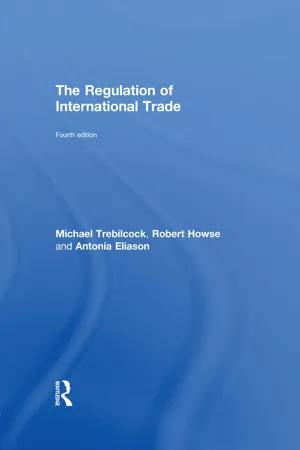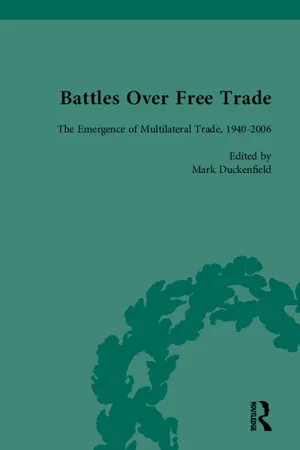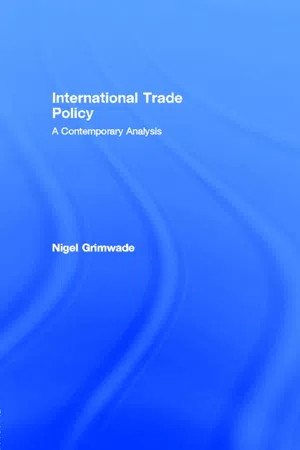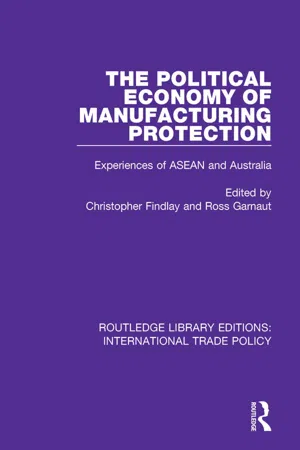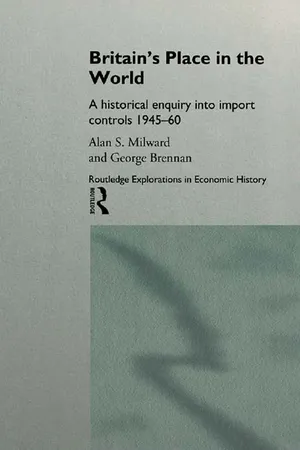Economics
Import Quotas
Import quotas are restrictions on the quantity of a specific good that can be imported into a country. They are typically set by the government and are used to protect domestic industries from foreign competition, control the balance of trade, and ensure national security. Import quotas can lead to higher prices for consumers and may also result in reduced product variety.
Written by Perlego with AI-assistance
Related key terms
8 Key excerpts on "Import Quotas"
- eBook - ePub
- W. Charles Sawyer, Richard L. Sprinkle(Authors)
- 2020(Publication Date)
- Routledge(Publisher)
Quotas restrict imports of a good to a certain quantitative level. In practice, this means that a country imposing a quota imports only a certain number of units of the good on an annual basis. Quotas are considered such an extreme form of protectionism that they are banned under international trade rules. Nevertheless, quotas still exist in various forms for five reasons.First, not all countries are members of the World Trade Organization (WTO). These countries are still free to impose quotas. Countries that are not members of the WTO include Afghanistan, Algeria, Azerbaijan, Belarus, Ethiopia, Iran, Iraq, Lebanon, Libya, Russian Federation, Sudan, Yemen, Ukraine, Kazakhstan, Tajikistan, and Uzbekistan. Quotas provide protection for domestic industries, but they also can accomplish another objective. For example, some countries may experience difficulties obtaining adequate amounts of foreign exchange to finance or buy all of their imports. In these circumstances, a country may choose to restrict imports through the use of a quota as a means of conserving foreign exchange. In the past, many developing countries were reluctant to join the GATT/WTO because the elimination of quotas was a condition of membership.Second, new members of the WTO are allowed to maintain their previously existing quotas for a specified period of time. For example, when a country joins the WTO, its trade regulations do not have to be in immediate compliance with WTO rules. Usually, an agreement is negotiated between the WTO and the country concerning a transition period. This transition period is designed to allow the country time to implement new trade regulations that are in compliance with WTO standards. To make this transition easier for countries joining the WTO, a lengthy transition period is normally granted. For example, when Mexico joined GATT (General Agreement on Tariffs and Trade) in 1986, the transition period was fifteen years. Such a situation is not untypical. From 1990 until the creation of the WTO in 1995, thirty-one countries joined the International Trade Organization, and since the WTO’s creation an additional thirty-seven countries have joined. For example, between 2000 and 2006, Albania, Armenia, Cambodia, China, Croatia, Georgia, Jordan, Lithuania, Macedonia, Moldova, Nepal, Oman, Saudia Arabia, Chinese Taipei (Taiwan customs area), Tonga, and Viet Nam joined the WTO. As such, all of the newly joined members of the WTO are in the process of eliminating their quotas. - eBook - ePub
The Regulation of International Trade
4th Edition
- Robert Howse, Antonia Eliason(Authors)
- 2013(Publication Date)
- Routledge(Publisher)
For example, governments in importing countries may seek to protect domestic industries by imposing quantitative restrictions (discussed later in this chapter). One means by which a government may impose a quantitative restriction is by creating a quota system. The ‘tariff–quota equivalence’ result indicates that the effects of tariffs and quotas on prices in perfectly competitive markets are equivalent. Furthermore, as protectionist devices, quotas have the virtue of definitively limiting the volume of imports and thus they provide a stronger assurance of protection to domestic producers. However, quotas also have the vice, depending on their design, of insulating domestic producers from most forms of foreign competition and thus they may encourage inefficient domestic production. Non-prohibitive tariffs may be surmountable by highly efficient or competitive producers. Under this type of instrument, there may still be some incentive for domestic producers to enhance their productive efficiency. Additionally, when there is only one producer of a product in a domestic market, a non-prohibitive tariff is more effective than a quota at inhibiting this producer’s ability to exercise monopoly power. 6 Another difference between tariffs and quotas relates to who collects the scarcity rents that they engender. Governments in importing countries collect revenues from nonprohibitive tariffs, while, depending on how they are allocated, domestic holders of Import Quotas or licences may collect scarcity rents. If quotas are allocated to foreign exporters, these firms may collect scarcity rents by charging more for their goods in the protected market, without being under any obligation to pay customs duties on the imports. Tariffs should also be distinguished from production subsidies designed to make domestic items artificially competitive with imports - eBook - ePub
Battles Over Free Trade, Volume 4
Anglo-American Experiences with International Trade, 1776-2010
- Mark Duckenfield(Author)
- 2017(Publication Date)
- Routledge(Publisher)
Quantitative restrictions on imports, such as Import Quotas and import licensing, are an ancient institution, but they became important again in times of peace only in the early 1930’s with the coming of the depression. As a means of warding off balance of payments deficits by restricting the volume of imports to the amount of foreign exchange available to pay for them, as a means of guaranteeing to domestic producers a minimum share of the domestic market, as concessions in bilateralistic bargains and in barter transactions, they can be more effective, more predictable in some of their effects, and more flexible than ordinary tariff duties. This has won them many friends in a period when all of these considerations have loomed large in public opinion. Quantitative import restrictions, moreover, are an indispensable adjunct of domestic crop-restriction or price-support programs.The State Department has since 1934 opposed quantitative restrictions on imports as inherently more objectionable in principle than ordinary import duties. The Congress and the Department of Agriculture have not seen eye-to-eye on this question with the State Department, and it has not been the State Department which emerged the victor. Congress has enacted some quota legislation. In a few instances the Department of State, seeking to avoid the introduction of Import Quotas which otherwise would have become legally or politically inevitable, has induced other countries to apply quotas on exports to the United States. This roundabout way of securing quantitative restriction of imports transfers to the exporting country both the obloquy and the burden of administration of the quotas, and compensates it by abandoning to it the gap between the market prices in the two countries.Import Quotas are open to the objections that as compared to ordinary import duties they lend themselves more readily to violation of the equality of treatment principle, and involve a greater degree of interference with the ordinary processes of the free market. If Import Quotas are allotted by countries, as is ordinarily the case, there is not much choice except between more or less arbitrary allotment and deliberately discriminatory allotment. There is no formula of allotment of quotas which can assure to each supplying country that share of the import market which would accrue to it if competitive processes in terms of available supply and price were the only determining factors. Global or unallotted Import Quotas, with imports admitted in order of entry until the maximum is reached, tend to favor neighboring countries and to result in a wasteful concentration of imports at the beginning of each quota period. Import Quotas as usually administered result in an excess of the price in the import market over the laid-down cost (including import duties, if any) of the imported commodity, and this excess goes as a windfall profit to the exporters, or to the importers. To this last objection, import licenses sold in the desired quantity to the highest bidders would not be open and they conform most closely to the equality of treatment principle, but this procedure might offer too much facility for monopolization of the import trade by a few dealers. Import Quotas, finally, are more rigid than import duties in the sense that until modified they constitute absolute ceilings for the volume of imports regardless of changes in business conditions. This, however, is partially offset by the fact that Import Quotas are usually made more subject to administrative discretion than are the levels of import duties, which, as revenue measures, often require legislation and are consequently more frequently revised than are statutory levels of import duty. - eBook - ePub
Firms and Markets
Essays in Honour of Basil Yamey
- K. Tucker, Charles Baden-Fuller(Authors)
- 2018(Publication Date)
- Routledge(Publisher)
8 These are common devices in the contemporary trading world. In international commodity agreements, minimum Import Quotas are often supplemented by maximum export quotas for individual countries — again a device that facilitates the transfer of the rent to existing exporters.3. Dynamic ConsiderationsLeaving aside uncertainty, the two additional considerations brought by time are (i) changing comparative advantage, and (ii) price instability.(i) Changing Comparative AdvantageIt is often argued that import tariffs (or production subsidies) are preferable to Import Quotas because they allow additional access to markets if comparative advantage moves in favour of exporters.9 In considering access over time, care again needs to be given to the objective of those imposing the restrictions. If the objective is specified only for the beginning of the time under consideration, weapons that permit additional trade as conditions change will be preferred by foreigners (unless the expected gain in trade is small relative to the rent-transfer that is possible with export quotas). Tariff restrictions and production subsidies are indeed to be preferred to Import Quotas from this point of view. The preference will be particularly strong for new exporters whose ability to compete with old exporters may be limited by quotas, particularly by quotas allocated to countries according to exports in a base period. However, additional access over time will not necessarily be achieved if policies are adjusted so as to achieve, despite changing comparative advantage, a fixed domestic or trade objective.10When the economic rent arising from trade restrictions that are designed to achieve a fixed domestic or trade objective remains in the importing country, any improvement in productivity by exporting countries will yield a pure transfer to the importing countries. Resources devoted to securing increased productivity (or export subsidies) will, from the point of view of exporters as a whole, yield a negative rate of return, as far as international trade is concerned. This does not mean that the return to particular exporting countries, or to particular exporters within those countries, will be negative, for they may be able to displace other exporters. But for the exporters as a whole the benefits pass wholly to the importing country. (See Sampson and Snape, 1980.) Both sets of countries, it appears, would be happier if the export prices could be raised to the level to give the desired result in the importing country — the importers would not have to impose restrictions and the exporters could take life easy (or cease subsidising exports). - eBook - ePub
International Trade Policy
A Contemporary Analysis
- Nigel Grimwade(Author)
- 2006(Publication Date)
- Routledge(Publisher)
2 . In the case of a tariff, a rise in demand is met fully by imports and the price does not rise at all.Finally, to a greater extent than tariffs, quotas are discriminatory although they do not have to be. Too often, they are targeted at the world’s lowest-cost suppliers of the product.There would therefore seem to be merit in taking a tougher attitude towards Import Quotas than towards tariffs. This is indeed the position of the GATT. Article XI opposes all forms of quantitative restriction on trade except in special circumstances. However, the exceptions have been extensively used such that Import Quotas remain an important barrier to trade. One exception is where quotas are needed to enforce ‘standards or regulations for the classification, grading or marketing of commodities in international trade’ (Article XI, 2: b). Another is agricultural products where restrictions are required in order to restrict domestic supply or to remove a temporary surplus of the domestic product (Article XI, 2: c). Quotas affecting agricultural imports were also subject to the 1955 waiver granted to the United States that arose out of a statute passed by Congress in 1951 mandating quotas on certain agricultural imports. Subsequently, other countries used the US waiver to excuse similar practices. (See Chapter 6 for a fuller discussion of agricultural protectionism.) Not surprisingly, quotas are much more common in agricultural trade.Article XII also permits the use of quotas for the purpose of safeguarding a country’s balance of payments. However, any such restrictions must be progressively relaxed as the country’s balance of payments improves. In other words, they are to be temporary. Interestingly, the GATT rules authorise quotas rather than tariffs where trade restrictions are needed for balance of payments conditions. In practice, countries have generally preferred tariff ‘surcharges’ as a device when faced with such difficulties. Developing countries, which frequently encounter balance of payments problems, have made considerable use of this provision to impose Import Quotas. Particularly important in this respect is Article XVIII of the GATT under which developing countries have fairly broad freedom to impose quantitative restrictions on imports for general developmental reasons (see Chapter 5 - eBook - ePub
Global Trade Policy
Questions and Answers
- Pamela J. Smith(Author)
- 2013(Publication Date)
- Wiley-Blackwell(Publisher)
The consumer's welfare increases by the surplus amount +(a* + b *). The net country welfare then is the sum of the producer and consumer welfare changes. Adding these effects together we get − (c* + d*), where area − (d *) is a consumption distortion and area − (d *) is a production distortion. In net, the exporting country is unambiguously worse off as a result of the ban. 7.3 Summary Remarks What are quantitative restrictions, their types and purpose? Quantitative restrictions are limitations on the amount of a good that is either exported from or imported into a country. Quantitative restrictions include Import Quotas, export quotas, voluntary export restraints, and bans. An import quota is a restriction imposed by the importer on the quantity of a good imported. The purpose of this policy is to restrict the purchase of goods from foreign origins in order to protect domestic producers. An export quota is a restriction imposed by the exporter on the quantity of a good exported. The primary purpose of this policy is to restrict the supply of the good in the international market in order to stabilize the world price of the good. A voluntary export restraint is a variant of the export quota, where the policy is imposed by the exporter at the request of the importer. The purpose of this policy is to forestall an official protective action by the importer. A ban or embargo is the extreme version of these policies, where either the exporter or importer restricts the quantity of trade in a good to zero. Quantitative restrictions create a rent associated with the traded good. The rent is the product of the markup in the price of the restricted good and the quantity of the good traded. This rent goes to the holder of the license rights to the traded good. In the case of a ban or embargo, the rent is zero. What are the effects of quantitative restrictions? The effects of quantitative restrictions depend on the conditions in the importing and exporting countries - eBook - ePub
The Political Economy of Manufacturing Protection
Experiences of ASEAN and Australia
- Christopher Findlay, Ross Garnaut(Authors)
- 2017(Publication Date)
- Routledge(Publisher)
257 SummaryThe objective of this paper is to analyse effects of two rapidly spreading forms of trade barriers, voluntary export restraints (VER) and Import Quotas. VERs are, by their nature, always source specific. Import Quotas are traditionally analysed as a nondiscriminatory measure but can also be preferential (source specific) in nature. The more source specific the import quota, the greater the ability to form an export cartel. However, VERs are unlikely to result in the whole rent being captured by the exporting country owing to intertemporal considerations. These formal bilateral trade barriers affect ‘outside’ countries as well, especially if one of the contracting partners is a member of a free trade area or EC. Also, trade restricting agreements, such as those between Japan and the United States, and West Europe and the United States, affect outside countries by increasing trade from other sources of supply. Because of the multicountry nature of the issue one has to distinguish between different situations in which the quantitative supply restrictions are applied (leaking or strict ones), between different sizes of the home country, and also take into account the extent to which trade limitations are acceptable internationally, so that they do not cause excessive welfare losses to the home country owing to retaliation. In the paper, different cases are analysed along these lines. Among several observations, it is noted that because, typically, there are constraints on how much it is politically feasible to reduce imports in the home country, and since the home country has little influence over commercial policy and export supply elasticities in exporting countries, it will have very limited control over the level of assistance given to its domestic producers through the domestic price. The paper ends with an analysis of the possible conflict of interests in trade, such as that in textiles and clothing, between industrialised country producers, established developing country exporters, and latecoming developing country exporters. - eBook - ePub
- George Brennan, Alan Milward(Authors)
- 2003(Publication Date)
- Routledge(Publisher)
ad valorem. Quota restriction can be imposed either on value or on volume of imports, and in many cases the quotas or purchasing programmes were kept so secret or unheralded that their existence seems to have gone unsuspected by many excellent authors.With the widespread application of the most-favoured-nation principle it is also objected against quotas that they can more easily and less detectably discriminate. But the main accusation is that quotas distort market relationships. Once the permitted quantity has been reached the price of external goods ceases to matter; the barrier comes down and no subsequent change of external price or internal demand can affect the amount imported. Even where the size of the quota or the purchasing programme is published, the extent of the demand which it frustrates can only be indirectly estimated; the connection between domestic demand and foreign supply is cut. In principle international and domestic supply costs could continue to widen indefinitely, but there would still be no market for imports.Quotas were effective in the absence of tariffs, and where tariffs existed reduced them to revenue taxes. Even in the low-import year 1952 ad valorem tariffs transferred a tidy £84 million (none of it from the Commonwealth areas unrestricted by quotas) from importers to government. But even in a year where a few permitted quotas exceeded demand, these duties can have had little deterrent effect on the level of imports. In the absence of quotas a tariff, by contrast, even when very high, still allows import prices to serve as a measure of potential demand. In equilibrium, an ad valorem tariff ideally measures the difference between international costs and domestic costs at the margin of production. Tariffs can still be an ineffective barrier if domestic demand is initially high enough to make it so, or if the foreign supplier in response to its imposition reduces the price of a good before duty is levied. But in any case a given tariff allows imports to respond in the longer run to a genuine change of international costs or to any change of domestic demand. If price elasticities are known, an effective ad valorem
Learn about this page
Index pages curate the most relevant extracts from our library of academic textbooks. They’ve been created using an in-house natural language model (NLM), each adding context and meaning to key research topics.

